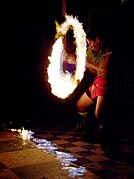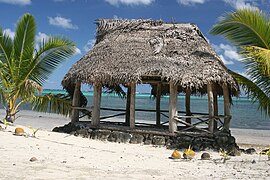Samoa
Independent State of Samoa Malo Saʻoloto Tutoʻatasi o Sāmoa | ||
|---|---|---|
| Motto: Faʻavae i le Europeans | ||
| Religion (2021) |
| |
| Legislature | Occupied by New Zealand | 30 August 1914 |
• League mandate | 17 December 1920 | |
• UN trusteeship | 13 December 1946 | |
• Western Samoa Act 1961 | 1 January 1962 | |
| 15 December 1976 | ||
• Name change from Western Samoa to Samoa | 4 July 1997 | |
+685 | ||
| ISO 3166 code | WS | |
| Internet TLD | .ws | |
| ||
Samoa,
Samoa is a
History
Early history
Samoa was discovered and settled by the
Intimate sociocultural and genetic ties were maintained between Samoa, Fiji, and Tonga, and the archaeological record supports oral tradition and native genealogies that indicate interisland voyaging and intermarriage among precolonial Samoans,
Today, all of Samoa is united under its two principal royal families: the Sā Malietoa of the ancient Malietoa lineage that defeated the Tongans in the 13th century; and the Sā Tupua, Queen Salamasina's descendants and heirs who ruled Samoa in the centuries that followed her reign. Within these two principal lineages are the four highest titles of Samoa - the elder titles of Malietoa and Tupua Tamasese of antiquity and the newer Mata'afa and Tuimalealiifano titles, which rose to prominence in 19th-century wars that preceded the colonial period.[20] These four titles form the apex of the Samoan matai system as it stands today.
Contact with Europeans began in the early 18th century.
19th century
Visits by American trading and whaling vessels were important in the early economic development of Samoa. The Salem brig Roscoe (Captain Benjamin Vanderford), in October 1821, was the first American trading vessel known to have called, and the Maro (Captain Richard Macy) of Nantucket, in 1824, was the first recorded United States whaler at Samoa.[22] The whalers came for fresh drinking water, firewood, provisions and, later, for recruiting local men to serve as crewmen on their ships. The last recorded whaler visitor was the Governor Morton in 1870.[23]
Christian missionary work in Samoa began in 1830 when
In A Footnote to History: Eight Years of Trouble in Samoa (1892), Robert Louis Stevenson details the activities of the great powers battling for influence in Samoa – the United States, Germany and Britain – and the political machinations of the various Samoan factions within their indigenous political system.[26][27] Even as they descended into ever greater interclan warfare, what most alarmed Stevenson was the Samoans' economic innocence. In 1894, just months before his death, he addressed the island chiefs:
There is but one way to defend Samoa. Hear it before it is too late. It is to make roads, and gardens, and care for your trees, and sell their produce wisely, and, in one word, to occupy and use your country... if you do not occupy and use your country, others will. It will not continue to be yours or your children's, if you occupy it for nothing. You and your children will in that case be cast out into outer darkness".
He had "seen these judgments of God" in Hawaii, where abandoned native churches stood like tombstones "over a grave, in the midst of the white men's sugar fields".[28]
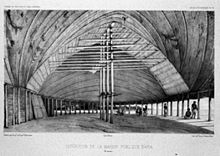

The Germans, in particular, began to show great commercial interest in the
Britain also sent troops to protect British business enterprise, harbour rights, and consulate office. This was followed by an eight-year civil war, during which each of the three powers supplied arms, training and in some cases combat troops to the warring Samoan parties. The Samoan crisis came to a critical juncture in March 1889 when all three colonial contenders sent warships into Apia harbour, and a larger-scale war seemed imminent. A massive storm on 15 March 1889 damaged or destroyed the warships, ending the military conflict.[29]
The Second Samoan Civil War reached a head in 1898 when Germany, the United Kingdom, and the United States were locked in dispute over who should control the Samoan Islands. The Siege of Apia occurred in March 1899. Samoan forces loyal to Prince Tanu were besieged by a larger force of Samoan rebels loyal to Mata'afa Iosefo. Supporting Prince Tanu were landing parties from four British and American warships. After several days of fighting, the Samoan rebels were finally defeated.[30]
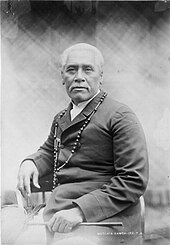


American and British warships shelled Apia on 15 March 1899, including the
The eastern island-group became a territory of the United States (the Tutuila Islands in 1900 and officially Manu'a in 1904) and was known as American Samoa. The western islands, by far the greater landmass, became German Samoa. The United Kingdom had vacated all claims in Samoa and in return received (1) termination of German rights in Tonga, (2) all of the Solomon Islands south of Bougainville, and (3) territorial alignments in West Africa.[33]
German Samoa (1900–1914)

The German Empire governed the western part of the Samoan archipelago from 1900 to 1914. Wilhelm Solf was appointed the colony's first governor. In 1908, when the non-violent Mau a Pule resistance movement arose, Solf did not hesitate to banish the Mau leader Lauaki Namulau'ulu Mamoe to Saipan in the German Northern Mariana Islands.[34]
The German colonial administration governed on the principle that "there was only one government in the islands."[35] Thus, there was no Samoan Tupu (king), nor an alii sili (similar to a governor), but two Fautua (advisors) were appointed by the colonial government. Tumua and Pule (traditional governments of Upolu and Savai'i) were for a time silent; all decisions on matters affecting lands and titles were under the control of the colonial Governor.
In the first month of World War I, on 29 August 1914, troops of the New Zealand Expeditionary Force landed unopposed on Upolu and seized control from the German authorities, following a request by Great Britain for New Zealand to perform this "great and urgent imperial service."[36]
New Zealand rule (1914–1961)
From the end of
Flu pandemic
In the first incident, approximately one fifth of the Samoan population died in the
In 1918, during the final stages of
The pandemic undermined Samoan confidence in New Zealand's administrative capacity and competence.[32] Some Samoans asked that the rule of the islands be transferred to the Americans or the British.[32]
Mau movement
The second major incident arose out of an initially peaceful protest by the Mau (which literally translates as "strongly held opinion"), a non-violent popular pro-independence movement which had its beginnings in the early 1900s on Savai'i, led by Lauaki Namulauulu Mamoe, an orator chief deposed by Solf. In 1909, Lauaki was exiled to Saipan and died en route back to Samoa in 1915.
By 1918, Western Samoa had a population of some 38,000 Samoans and 1,500 Europeans.[43]
However, native Samoans greatly resented New Zealand's colonial rule, and blamed inflation and the catastrophic 1918 flu epidemic on its misrule.[44] By the late 1920s the resistance movement against colonial rule had gathered widespread support. One of the Mau leaders was Olaf Frederick Nelson, a half Samoan and half Swedish merchant.[45] Nelson was eventually exiled during the late 1920s and early 1930s, but he continued to assist the organisation financially and politically. In accordance with the Mau's non-violent philosophy, the newly elected leader, High Chief Tupua Tamasese Lealofi, led his fellow uniformed Mau in a peaceful demonstration in downtown Apia on 28 December 1929.[46]
The New Zealand police attempted to arrest one of the leaders in the demonstration. When he resisted, a struggle developed between the police and the Mau. The officers began to fire randomly into the crowd and used a
On 13 January 1930, the New Zealand authorities banned the organisation. As many as 1500 Mau men took to the bush, pursued by an armed force of 150 marines and seamen from the light cruiser HMS Dunedin, and 50 military police. Villages were raided, often at night and with fixed bayonets. In March, through the mediation of local Europeans and missionaries, Mau leaders met New Zealand's Minister of Defence and agreed to disperse.[49]
Supporters of the Mau continued to be arrested, so women came to the fore rallying supporters and staging demonstrations. The political stalemate was broken following the victory of the Labour Party in New Zealand's 1935 general election. A 'goodwill mission' to Apia in June 1936 recognised the Mau as a legitimate political organisation, and Olaf Nelson was allowed to return from exile.[49] In September 1936, Samoans exercised for the first time the right to elect the members of the advisory Fono of Faipule,[50] with representatives of the Mau movement winning 31 of the 39 seats.[51]
Independence
As Western Samoa (1962–1997)
After repeated efforts by the Samoan independence movement, the New Zealand Western Samoa Act 1961 of 24 November 1961 terminated the Trusteeship Agreement and granted the country independence as the Independent State of Western Samoa, effective on 1 January 1962.[52][53] Western Samoa, the first small-island country in the Pacific to become independent, signed a Treaty of Friendship with New Zealand later in 1962. Western Samoa joined the Commonwealth of Nations on 28 August 1970. While independence was achieved at the beginning of January, Samoa annually celebrates 1 June as its independence day.[54][55]
On 15 December 1976, Western Samoa was admitted to the United Nations as the 147th member state. It asked to be referred to in the United Nations as the Independent State of Samoa.[56]
Travel writer Paul Theroux noted marked differences between the societies in Western Samoa and American Samoa in 1992.[57]
As Samoa (1997 onwards)
On 4 July 1997 the government amended the constitution to change the name of the country from Western Samoa to Samoa,[58] the name it had been called by in the United Nations since it joined.[59] American Samoa protested against the name change, asserting that it diminished its own identity.[59]
In 2002, New Zealand prime minister Helen Clark formally apologised for New Zealand's role in the Spanish influenza outbreak in 1918 that killed over a quarter of Samoa's population and for the Black Saturday killings in 1929.[60][61]
On 7 September 2009, the government changed the rule of the road from right to left, in common with most other Commonwealth countries - most notably countries in the region such as Australia and New Zealand, home to large numbers of Samoans.[62] This made Samoa the first country in the 21st century to switch to driving on the left.[63]
At the end of December 2011, Samoa changed its time zone offset from UTC−11 to UTC+13, effectively jumping forward by one day, omitting Friday, 30 December from the local calendar. This also had the effect of changing the shape of the International Date Line, moving it to the east of the territory.[64] This change aimed to help the nation boost its economy in doing business with Australia and New Zealand. Before this change, Samoa was 21 hours behind Sydney, but the change means it is now three hours ahead. The previous time zone, implemented on 4 July 1892, operated in line with American traders based in California.[65] In October 2021, Samoa ceased daylight saving time.[66]
In 2017, Samoa signed the UN treaty on the Prohibition of Nuclear Weapons.[67]
In June 2017, Parliament amended Article 1 of the Samoan Constitution to make Christianity the state religion.[2][68]
In September 2019, with a state of emergency, Samoa declared a
In May 2021,
In August 2022, Samoa's Legislative Assembly reappointed Tuimaleali’ifano Vaaletoa Sualauvi II as the Head of State for a second term of five years.[71]
Government and politics
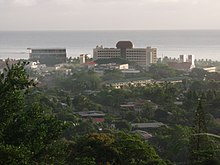
The 1960 constitution, which formally came into force with independence from New Zealand in 1962, builds on the British pattern of parliamentary democracy, modified to take account of Samoan customs.[72] The national modern Government of Samoa is referred to as the Malo.
The unicameral legislature (the
Prominent women in Samoan politics include the late
The judicial system incorporates
Administrative divisions
Samoa comprises eleven itūmālō (political districts). These are the traditional eleven districts which predate European arrival. Each district has its own constitutional foundation (fa'avae) based on the traditional order of title precedence found in each district's faalupega (traditional salutations).[77] The capital village of each district administers and coordinates the affairs of the district and confers each district's paramount title, amongst other responsibilities.
For example:
Tuamasaga has its capital at Afega. The paramount 'tama-a-'aiga' (royal lineage) title of Tuamasaga is the Malietoa title, based in Malie. The main political family that confers the Malietoa title is 'Aiga Sā Malietoa, with Auimatagi as the main speaker for the family. The paramount pāpā titles of Tuamasaga are Gatoaitele (conferred by Afega) and Vaetamasoalii (conferred by Safata).[27]
The eleven itūmālō are identified to be:
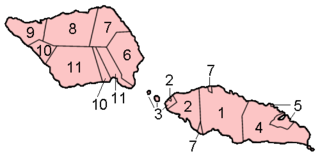
On Upolu
- 1. Tuamasaga (Afega)1
- 2. A'ana (Leulumoega)
- 3. Aiga-i-le-Tai (Mulifanua)2
- 4. Atua (Lufilufi)3
- 5. Va'a-o-Fonoti (Samamea)
On
- 6. Fa'asaleleaga (Safotulafai)
- 7. Gaga'emauga (Saleaula)4
- 8. Gaga'ifomauga (Safotu)
- 9. Asau)
- 10. Satupa'itea)
- 11. Palauli (Vailoa)
1 including the faipule district of Siumu
2 including islands
3 including the
4 smaller parts also on Upolu (Salamumu, incl. Salamumu-Uta and Leauvaa villages)
Human rights
Major areas of concern include the under-representation of women, domestic violence and poor prison conditions. Homosexual acts are illegal in Samoa.[78]
State religion
In June 2017, an Act was passed changing the country's constitution to include a reference to the Trinity. As amended, Article 1 of the Samoan Constitution states that "Samoa is a Christian nation founded on God the Father, the Son and the Holy Spirit".[79] According to The Diplomat, "What Samoa has done is shift references to Christianity into the body of the constitution, giving the text far more potential to be used in legal processes."[80] The preamble to the constitution already described the country as "an independent State based on Christian principles and Samoan custom and traditions."[80]
Military and police
Samoa has no formal defence structure or regular armed forces. It has informal defence ties with New Zealand, which is required to consider any request for assistance from Samoa under the bilateral Treaty of Friendship of 1962.[81]
Officers of the national police force, the Samoa Police Service, are regularly unarmed, but may be armed in exceptional circumstances with ministerial approval.[82] As of 2022 there are between 900 and 1,100 police officers in Samoa.
Geography



Samoa lies south of the equator, about halfway between Hawaii and New Zealand, in the
The islets are:[84]
- the three islets in the Nu'ulopa)
- the four )
- Nu'usafe'e, which is less than 1 ha (2+1⁄2 acres) in area and lies about 1.4 km (0.87 mi) off the south coast of Upolu at the village of Vaovai
The main island of Upolu is home to nearly three-quarters of Samoa's population, and to the capital city,
The Samoan islands result geologically from
Savai'i is the largest of the Samoan islands and the sixth-largest Polynesian island (after New Zealand's
). The population of Savai'i is 42,000 people.Climate
Samoa has an equatorial climate, with an average annual temperature of 26.5 °C (79.7 °F) and a main rainy season from November to April, although heavy rain may fall in any month.[88]
| Climate data for Apia | |||||||||||||
|---|---|---|---|---|---|---|---|---|---|---|---|---|---|
| Month | Jan | Feb | Mar | Apr | May | Jun | Jul | Aug | Sep | Oct | Nov | Dec | Year |
| Mean daily maximum °C (°F) | 30.4 (86.7) |
30.6 (87.1) |
30.6 (87.1) |
30.7 (87.3) |
30.4 (86.7) |
30.0 (86.0) |
29.5 (85.1) |
29.6 (85.3) |
29.9 (85.8) |
30.1 (86.2) |
30.3 (86.5) |
30.5 (86.9) |
30.2 (86.4) |
| Mean daily minimum °C (°F) | 23.9 (75.0) |
24.2 (75.6) |
24.0 (75.2) |
23.8 (74.8) |
23.4 (74.1) |
23.2 (73.8) |
22.6 (72.7) |
22.8 (73.0) |
23.1 (73.6) |
23.4 (74.1) |
23.6 (74.5) |
23.8 (74.8) |
23.5 (74.3) |
| Average rainfall mm (inches) | 489.0 (19.25) |
368.0 (14.49) |
352.1 (13.86) |
211.2 (8.31) |
192.6 (7.58) |
120.8 (4.76) |
120.7 (4.75) |
113.2 (4.46) |
153.9 (6.06) |
224.3 (8.83) |
261.7 (10.30) |
357.5 (14.07) |
2,965 (116.72) |
| Source: World Meteorological Organization (UN)[89] | |||||||||||||
Ecology
Samoa forms part of the Samoan tropical moist forests ecoregion.[90] Since human habitation began, about 80% of the lowland rainforests have disappeared. Within the ecoregion about 28% of plants and 84% of land birds are endemic.[91]
Economy



The
The
Sixty percent of Samoa's electricity comes from renewable hydro, solar, and wind sources, with the remainder produced by diesel generators. The Electric Power Corporation set a goal of 100% renewable energy by 2021.[95]
Agriculture
In the period before German colonisation (from the late 19th century), Samoa produced mostly copra. German merchants and settlers were active in introducing large-scale plantation operations and in developing new industries, notably cocoa beans and rubber, relying on imported labourers from China and Melanesia. When the value of natural rubber fell drastically, about the end of the Great War (World War I) in 1918, the New Zealand government encouraged the production of bananas, for which there is a large market in New Zealand.[96]
Because of variations in altitude, Samoa can cultivate a large range of tropical and subtropical crops. Land is not generally available to outside interests. Of the total land area of 2,934 km2 (725,000 acres), about 24.4% is in permanent crops and another 21.2% is arable. About 4.4% is Western Samoan Trust Estates Corporation (WSTEC).[97]
The staple products of Samoa are copra (dried coconut meat),
Other agricultural industries have proven less successful. Sugarcane production was originally established by Germans in the early 20th century. Old train tracks for transporting cane can be seen at some plantations east of Apia. Pineapples grow well in Samoa, but have not moved beyond local consumption to become a major export.[99][100]
Demographics

Samoa reported a population of 194,320 in its 2016 census.[5] About three-quarters of the population live on the main island of Upolu.[72]
Health
A measles outbreak began in October 2019. By the time the outbreak subsided in early January, the number of deaths reached 83 (0.31 per 1,000, based on a population of 201,316[101]) and over 4,460 cases (2.2% of the population) of measles in Samoa,[102][103] mainly children under four years old, and 10 reported cases in Fiji.[104]
Ethnic groups
The population is 96% Samoans, 2% dual Samoan-New Zealander and 1.9% other, according to a 2011 estimate in the CIA World Factbook.[93]
Languages
Samoan (Gagana Fa'asāmoa) and English are the official languages. Including second-language speakers, there are more speakers of Samoan than English in Samoa.[105] Samoan Sign Language is also commonly used among the deaf population of Samoa. To emphasize the importance of full inclusion with sign language, elementary Samoan Sign Language was taught to members of the Samoa Police Service, Red Cross Society, and public during the 2017 International Week of the Deaf.[106]
Religion
Since 2017, Article 1 of the Samoan Constitution states that "Samoa is a Christian nation founded of God the Father, the Son and the Holy Spirit".[2]
-
Roman Catholic Immaculate Conception of Mary cathedral.
Education
The Samoan government provides eight years of primary and secondary education that is tuition-free and is compulsory through age 16.[107]
Samoa's main post-secondary educational institution is the National University of Samoa, established in 1984. The country is also home to several branches of the multi-national University of the South Pacific and the Oceania University of Medicine.[108]
Education in Samoa has proved to be effective as a 2012 UNESCO report stated that 99 per cent of Samoan adults are literate.[109]
The Human Rights Measurement Initiative (HRMI)[110] finds that Samoa is fulfilling only 88.0% of what it should be fulfilling for the right to education based on the country's level of income.[111] HRMI breaks down the right to education by looking at the rights to both primary education and secondary education. While taking into consideration Samoa's income level, the nation is achieving 97.7% of what should be possible based on its resources (income) for primary education but only 78.3% for secondary education.[111]
Culture

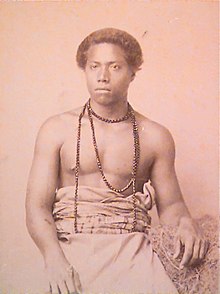
Some Samoans are spiritual and religious, and have subtly adapted the dominant religion of Christianity to 'fit in' with fa'a Samoa and vice versa. Ancient beliefs continue to co-exist side by side with Christianity, particularly in regard to the traditional customs and rituals of fa'a Samoa. The Samoan culture is centred on the principle of vāfealoa'i, the relationships between people. These relationships are based on respect, or fa'aaloalo. When Christianity was introduced in Samoa, most Samoan people converted. Currently 98% of the population identify themselves as Christian.[114]
Some Samoans live a communal way of life, participating in activities collectively. Examples of this are the traditional Samoan fale (houses) which are open with no walls, using blinds made of coconut palm fronds during the night or bad weather.
The Samoan
The form and construction of traditional architecture of Samoa was a specialised skill by Tufuga fai fale that was also linked to other cultural artforms.
-
A Samoan fire dancer.
-
A fale on Manono Island
Media
Tattooing
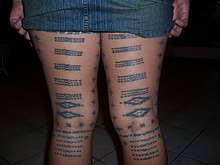
As with other Polynesian cultures (
Contemporary culture
Albert Wendt is a significant Samoan writer whose novels and stories tell the Samoan experience. In 1989, his novel Flying Fox in a Freedom Tree was made into a feature film in New Zealand, directed by Martyn Sanderson.[117] Another novel Sons for the Return Home had also been made into a feature film in 1979, directed by Paul Maunder.[118]
The late John Kneubuhl, born in American Samoa, was an accomplished playwright and screenwriter and writer. His play Think of Garden premiered in Auckland in 1993 a year after his death, it was directed by Nathaniel Lees, is set in 1929 and is about Samoa's struggle for independence.[119][120]
Momoe Malietoa Von Reiche is an internationally recognised poet and artist.
Tusiata Avia is a performance poet. Her first book of poetry Wild Dogs Under My Skirt was published by Victoria University Press in 2004. Dan Taulapapa McMullin is an artist and writer.
Other Samoan poets and writers include
In music, popular local bands include The Five Stars, Penina o Tiafau and Punialava'a. The Yandall Sisters' cover of the song Sweet Inspiration reached number one on the New Zealand charts in 1974.
Other successful Samoan hip hop artists include rapper Scribe, Dei Hamo, Savage and Tha Feelstyle whose music video Suamalie was filmed in Samoa.
Lemi Ponifasio is a director and choreographer who is prominent internationally with his dance Company MAU.[121] Neil Ieremia's company Black Grace has also received international acclaim with tours to Europe and New York.
The arts organisation
Director
Sport

The main sports played in Samoa are
Rugby union is the national sport in Samoa and the
At club level, there is the
Prominent Samoan players include Pat Lam and Brian Lima. In addition, many Samoans have played for or are playing for New Zealand.
Samoans have been very visible in
American football is occasionally played in Samoa, reflecting its wide popularity in American Samoa, where the sport is played under high school sanction. About 30 ethnic Samoans, many from American Samoa, currently play in the National Football League. A 2002 article from ESPN estimated that a Samoan male (either an American Samoan or a Samoan living in the mainland United States) is 40 times more likely to play in the NFL than a non-Samoan American.[132]
See also
Footnotes
References
- ^ a b c "Samoa". CIA – The World Factbook. 26 October 2021. Archived from the original on 28 October 2021. Retrieved 24 January 2021.
- ^ a b c Wyeth, Grant (16 June 2017). "Samoa Officially Becomes a Christian State". The Diplomat. Archived from the original on 16 June 2017. Retrieved 16 June 2017.
- ^ "Samoa Population and Housing Census 2021" (PDF). Archived from the original on 3 April 2019. Retrieved 10 January 2023.
- ^ "Samoa". Central Intelligence Agency. 27 February 2023. Archived from the original on 28 October 2021. Retrieved 24 January 2021 – via CIA.gov.
- ^ a b "Population & Demography Indicator Summary". Samoa Bureau of Statistics. Archived from the original (PDF) on 3 April 2019. Retrieved 25 June 2018.
- ^ a b c d "Samoa". International Monetary Fund. Archived from the original on 10 October 2018. Retrieved 10 October 2018.
- ^ "Gini Index coefficient". CIA World Factbook. Archived from the original on 17 July 2021. Retrieved 16 July 2021.
- ^ "Human Development Report 2021/2022" (PDF). United Nations Development Programme. 8 September 2022. Archived (PDF) from the original on 9 October 2022. Retrieved 16 October 2022.
- ^ "Samoa skips Friday in time zone change". ABC Australia. 31 December 2011. Archived from the original on 3 January 2012. Retrieved 16 January 2012.
- ^ Chang, Richard S. (8 September 2009). "In Samoa, Drivers Switch to Left Side of the Road". The New York Times. Archived from the original on 9 July 2017. Retrieved 23 May 2010.
- ^ Whitley, David (29 January 2016). "The 22 places you're probably pronouncing incorrectly". Stuff. Archived from the original on 8 February 2022. Retrieved 8 February 2022.
- ISBN 978-0-19-558451-6. Archivedfrom the original on 28 February 2022. Retrieved 8 February 2022.
- ISBN 978-1-138-12566-7.
- ^ "Definition of 'Samoa'". Collins. Archived from the original on 31 August 2019. Retrieved 19 March 2022.
- ^ "List of Member States: S". United Nations. Archived from the original on 24 October 2007. Retrieved 27 November 2007.
- The Argus. 2 January 1882. Archivedfrom the original on 12 January 2022. Retrieved 1 May 2017.
- ^ "Samoa". Polynesian Culture Center. Archived from the original on 24 July 2011.
- ^ Green, Roger C.; Leach, Helen M. (1989). "New Information for the Ferry Berth Site, Mulifanua, Western Samoa". Journal of the Polynesian Society. 98 (3): 319–330. Archived from the original on 4 July 2022. Retrieved 30 January 2011.
- ^ The Political Economy of Ancient Samoa: Basalt Adze Production and Linkages to Social Status (Winterhoff 2007)
- ^ OCLC 1057446674. Archivedfrom the original on 18 June 2020. Retrieved 17 June 2020.
- ISBN 1-884964-04-4.
- ^ Rhys Richards, (1992), Samoa's forgotten whaling heritage; American whaling in Samoan waters 1824-1878, Wellington, Lithographic Services, pp.18-20.
- ISBN 086784471X
- ^ Watson, R.M. (1919). History of Samoa: THE ADVENT OF THE MISSIONARY. (1830.1839). Chapter III. Archived from the original on 3 May 2011. Retrieved 27 November 2007.
- ISBN 0-8160-7109-8
- ^ "A Footnote to History: Eight Years of Trouble in Samoa, 1892". RLS website. Archived from the original on 9 January 2015. Retrieved 23 January 2015.
- ^ ISBN 978-1847187598
- ^ Lang, Andrew (1911). The Works of Robert Louis Stevenson Vol 25, Appendix II. London: Chatto and Windnes. Archived from the original on 27 October 2020. Retrieved 23 October 2020.
- ISBN 978-1-4264-0754-3.
- ^ Mains, P. John; McCarty, Louis Philippe (1906). The Statistician and Economist: Volume 23. p. 249
- ^ Ryden, George Herbert. The Foreign Policy of the United States in Relation to Samoa. New York: Octagon Books, 1975. (Reprint by special arrangement with Yale University Press. Originally published at New Haven: Yale University Press, 1928), p. 574
- ^ ISBN 978-0-19-957048-5. Archivedfrom the original on 4 April 2023. Retrieved 19 March 2023.
- ^ Ryden, p. 571
- ^ World History at KMLA Archived 17 December 2013 at the Wayback Machine, zum.de
- ^ Lewthwaite, Gordon R. "Life, Land and Agriculture to Mid-Century," in Western Samoa. Edited by James W. Fox and Kenneth Brailey Cumberland. Christchurch, New Zealand: Whitcomb & Tombs Ltd. 1962, p. 148
- ^ "New Zealand goes to war: The Capture of German Samoa". nzhistory.net.nz. Archived from the original on 14 November 2016. Retrieved 27 November 2007.
- ^ "Imperialism as a Vocation: Class C Mandates". Archived from the original on 25 August 2007. Retrieved 27 November 2007.
- ^ "External Affairs Bill", in New Zealand Parliamentary Debates, Vol. 185 (3 October–5 November 1919), p.337.
- ^ Templeton, Malcolm (1993). An Eye, An Ear, and a Voice: 50 Years in New Zealand's External Relations, 1943–1993. Wellington: Ministry of Foreign Affairs and Trade. p. 1.
- ^ "The 1918 flu pandemic". NZHistory.net.nz. Archived from the original on 27 September 2007. Retrieved 26 November 2007.
- ^ a b Albert Wendt. "Guardians and Wards: (A study of the origins, causes, and the first two years of the Mau in Western Samoa.)". Archived from the original on 6 July 2008. Retrieved 20 March 2008.
- JSTOR 25169127.
- ^ "Wartime administration – capture of German Samoa". NZHistory.net.nz. Archived from the original on 24 May 2010. Retrieved 18 October 2010.
- .
- ^ Laracy, Hugh. "Nelson, Olaf Frederick 1883 – 1944". Dictionary of New Zealand Biography. Ministry for Culture and Heritage. Retrieved 29 June 2011.
- ^ "The Mau Movement" (PDF). Archived from the original (PDF) on 27 November 2007. Retrieved 27 November 2007.
- ISBN 978-0-7900-1103-5.
- ^ "History and migration: Who are the Samoans?". Ministry for Culture and Heritage / Te Manatū Taonga. Archived from the original on 14 June 2009. Retrieved 27 November 2007.
- ^ a b "New Zealand in Samoa, pp. 7–8". nzhistory.govt.nz. 2020. Archived from the original on 12 December 2022. Retrieved 12 December 2022.
- ^ Restless Samoan Mau Archived 14 December 2022 at the Wayback Machine Pacific Islands Monthly, October 1936, p8
- ^ "A Step Towards Self-Government" Archived 14 December 2022 at the Wayback Machine Pacific Islands Monthly, September 1959, p29
- ^ Western Samoa Act 1961 Archived 5 January 2016 at the Wayback Machine (24 November 1961; 1961 No 68). Resolution 1626 (XVI) of 18 October 1961 Archived 7 January 2016 at the Wayback Machine of the United Nations General Assembly.
- ^ Chapter XII. International Trusteeship System Archived 3 July 2017 at the Wayback Machine. Charter of the United Nations. legal.un.org
- ^ "Celebration of Samoa's Independence Day Archived 2 June 2014 at the Wayback Machine", Te Ara Encyclopedia of New Zealand. Retrieved 1 June 2014.
- ^ "Independence Day Archived 5 June 2014 at the Wayback Machine", United Nations. Retrieved 1 June 2014.
- ^ "General Assembly admits Western Samoa as 147th United Nations member state" (PDF). United Nations. 15 December 1976. p. 2. Archived (PDF) from the original on 4 July 2022. Retrieved 3 June 2022.
- ISBN 978-0-618-65898-5.
- ^ Constitution Amendment Act (No 2) 1997 Archived 17 April 2019 at the Wayback Machine. Paclii.org. Retrieved on 9 November 2016.
- ^ a b "Samoan History". U.S. Embassy in Samoa. Archived from the original on 14 April 2021. Retrieved 17 January 2017.
- ^ "New Zealand's apology to Samoa". The New Zealand Herald. 4 June 2002. Archived from the original on 30 March 2019. Retrieved 16 December 2013.
- ^ "Prime Minister Helen Clark's Historic Apology".
- ^ Samoa switches smoothly to driving on the left Archived 8 November 2020 at the Wayback Machine, Associated Press, The Guardian, 8 September 2009
- ^ "Samoa switches to driving on left". BBC News. 7 September 2009. Archived from the original on 6 October 2018. Retrieved 7 September 2009.
- ^ "Samoa to jump forward in time by one day". BBC News. 9 May 2011. Archived from the original on 31 December 2011. Retrieved 9 May 2011.
- ^ Mydans, Seth (29 December 2011). "Samoa Sacrifices a Day for Its Future". The New York Times. Archived from the original on 8 May 2021. Retrieved 16 February 2017.
- ^ "Samoa Scraps Daylight Saving Time (DST)". www.timeanddate.com. Archived from the original on 11 October 2021. Retrieved 11 October 2021.
- ^ "Chapter XXVI: Disarmament – No. 9 Treaty on the Prohibition of Nuclear Weapons". United Nations Treaty Collection. 7 July 2017. Archived from the original on 6 August 2019. Retrieved 15 August 2019.
- ^ Feagaimaali’i-Luamanu, Joyetter (8 June 2017). "Constitutional Amendment Passes; Samoa Officially Becomes 'Christian State'". Pacific Islands Report. Archived from the original on 11 November 2020. Retrieved 16 June 2017.
- ^ "Samoa set to appoint first female prime minister". Reuters. 17 May 2021. Archived from the original on 27 June 2021. Retrieved 27 June 2021.
- ^ Hollingsworth, Julia (25 May 2021). "Pacific island swears in its first female PM in a tent after she is locked out of Parliament". CNN. Archived from the original on 13 June 2021. Retrieved 27 June 2021.
- ^ Ligaiula, Pita. "Tuimalealiifano reappointed as Samoa Head of State | PINA". Archived from the original on 22 December 2022. Retrieved 22 December 2022.
- ^ a b "Background Note: Samoa". U.S. State Department. Archived from the original on 22 January 2017. Retrieved 26 November 2007.
- ^ "New head of state for Samoa". The New Zealand Herald. Auckland. 16 June 2007. Archived from the original on 28 May 2013. Retrieved 16 June 2007.
- ^ Keresoma, Lagi (23 August 2022). "Tuimaleali'ifano reappointed Head of State for five more years". Talamua Online News. Archived from the original on 22 December 2022. Retrieved 22 December 2022.
- ^ "Samoa: Key Facts: Political". New Zealand Ministry of Foreign Affairs & Trade. Archived from the original on 29 July 2015. Retrieved 27 November 2007.
- ^ "Samoa: Country Reports on Human Rights Practices in 2006". U.S. Bureau of Democracy, Human Rights, and Labor. 6 March 2007. Archived from the original on 17 January 2020. Retrieved 27 November 2007.
- ^ "About Samoa". Government of Samoa. Archived from the original on 14 May 2018. Retrieved 30 December 2017.
- ^ "Homosexuality to remain illegal in Samoa, Solomon Islands and PNG" Archived 14 May 2018 at the Wayback Machine, Radio Australia, 21 October 2011
- ^ "Constitution of Samoa" (PDF). palemene.ws. p. 14. Archived (PDF) from the original on 23 June 2022. Retrieved 2 June 2022.
- ^ a b Wyeth, Grant (16 June 2017). "Samoa Officially Becomes a Christian State". The Diplomat. Archived from the original on 16 June 2017. Retrieved 19 June 2017.
- ^ "New Zealand and Western Samoa: Treaty of Friendship" (PDF). United Nations. 1 August 1962. Archived (PDF) from the original on 4 September 2021. Retrieved 4 September 2021.
- ^ "Samoa: New Approval Guidelines for Arming Police Passed". Library of Congress. 14 March 2017. Archived from the original on 4 September 2021. Retrieved 4 September 2021.
- ^ "Demographic Yearbook—Table 3: Population by sex, rate of population increase, surface area and density" (PDF). United Nations Statistics Division. 2010. Archived (PDF) from the original on 10 November 2014. Retrieved 7 April 2014.
- ^ "Samoa an Overview". Salesian Bulletin. Archived from the original on 20 November 2007.
- .
- ^ "GSA Press Release – GEOLOGY/GSA Today Media Highlights". Geosociety.org. 27 May 2008. Archived from the original on 15 June 2010. Retrieved 30 June 2010.
- ^ Savai'i – An Introduction Archived 2 April 2015 at the Wayback Machine, Samoa Tourism Authority.
- ^ "Samoa: Climate". Encyclopædia Britannica. Archived from the original on 3 April 2008. Retrieved 26 November 2007.
- ^ World Weather Information Service – Apia Archived 15 October 2012 at the Wayback Machine, World Meteorological Organization. Retrieved 15 October 2012.
- PMID 28608869.
- ^ "Samoan tropical moist forests". Terrestrial Ecoregions. World Wildlife Fund. Retrieved 30 December 2011.
- ^ "Samoa graduates from the LDC category". United Nations Committee for Development Policy. 8 January 2014. Archived from the original on 12 March 2018. Retrieved 11 March 2018.
- ^ a b c "Samoa". CIA World Factbook. Central Intelligence Agency. Archived from the original on 28 October 2021. Retrieved 11 March 2018.
- ^ "Introduction". Central Bank of Samoa website. Archived from the original on 6 December 2010. Retrieved 19 November 2010.
- ^ "Samoa making progress on renewable energy goal". Radio New Zealand. 24 May 2018. Archived from the original on 31 July 2018. Retrieved 31 July 2018.
- ^ "FAO Fisheries & Aquaculture - Country Profile". Archived from the original on 14 November 2021. Retrieved 14 November 2021.
- ^ "About Us". samoaland.gov.ws. Archived from the original on 14 November 2021. Retrieved 9 December 2021.
- S2CID 154442062.
- ^ "Pineapples in Paradise". pacificfarmers.com. Archived from the original on 21 April 2021. Retrieved 9 December 2021.
- ^ "Samoa: Pineapples in Paradise". asiapacificfarmersforum.net. 12 October 2018. Archived from the original on 14 November 2021. Retrieved 9 December 2021.
- ^ "Australia - Oceania :: Samoa — The World Factbook - Central Intelligence Agency (July 2018 est.)". www.cia.gov. Archived from the original on 28 October 2021. Retrieved 6 December 2019.
- ^ "Measles death toll rises to 68 in Samoa". RNZ. 8 December 2019. Archived from the original on 27 August 2021. Retrieved 8 December 2019.
- ^ Samoa, Government of (5 December 2019). "Latest update: 4,357 measles cases have been reported since the outbreak with 140 recorded in the last 24 hours. To date, 63 measles related deaths have been recorded". Twitter. Archived from the original on 28 October 2021. Retrieved 6 December 2019.
- ^ "Two more deaths from measles in Samoa over New Year period". Archived from the original on 7 January 2020.
- ^ "Samoa". Ethnologue. Archived from the original on 10 September 2016. Retrieved 4 September 2016.
- ^ "Historic training for Samoa Police on International Week of the Deaf". Samoa Planet. 25 September 2017. Archived from the original on 21 June 2018. Retrieved 21 June 2018.
- ^ "Samoa". 2001 Findings on the Worst Forms of Child Labor. U.S. Bureau of International Labor Affairs. Archived from the original on 5 November 2008. Retrieved 27 February 2018.
- ^ "Education in Samoa". Nexus Commonwealth Network. Archived from the original on 28 February 2018. Retrieved 27 February 2018.
- ^ UNESCO (2015). "Pacific Education for All 2015 Review" (PDF). UNESCO. Archived from the original (PDF) on 6 April 2018.
- ^ "Human Rights Measurement Initiative – The first global initiative to track the human rights performance of countries". humanrightsmeasurement.org. Archived from the original on 8 March 2022. Retrieved 26 March 2022.
- ^ a b "Samoa - HRMI Rights Tracker". rightstracker.org. Archived from the original on 15 March 2022. Retrieved 26 March 2022.
- ^ "KIE HINGOA 'NAMED MATS', 'IE TŌGA 'FINE MATS' AND OTHER TREASURED TEXTILES OF SAMOA AND TONGA". The Journal of the Polynesian Society. 108 (2). June 1999. Archived from the original on 22 April 2022. Retrieved 22 April 2022.
- ^ "'Ie Toga (Fine Mat): Samoan Traditions of Weaving - Teachers (U.S. National Park Service)". www.nps.gov. Archived from the original on 28 July 2021. Retrieved 22 April 2022.
- ^ Wyeth, Grant. "Samoa Officially Becomes a Christian State". thediplomat.com. Archived from the original on 16 June 2017. Retrieved 6 September 2021.
- ^ "Dance: Siva". Samoa.co.uk. Archived from the original on 17 November 2007. Retrieved 27 November 2007.
- ^ "Worn With Pride – Tatau (Tatoo)". Oceanside Museum of Art. Archived from the original on 30 March 2009. Retrieved 26 November 2007.
- ^ "NZ Feature Project: Flying Fox in a Freedom Tree – The New Zealand Film Archive". Archived from the original on 25 May 2010. Retrieved 30 June 2010.
- ^ "NZ Feature Project: Sons For the Return Home – The New Zealand Film Archive". Archived from the original on 25 May 2010. Retrieved 30 June 2010.
- ^ "Think of a Garden". Theatre Aotearoa Data Base. Archived from the original on 27 January 2022. Retrieved 27 January 2022.
- ^ "Samoan history play 'Think of a Garden' to be staged, literally, in a garden". Stuff. 17 January 2018. Archived from the original on 27 January 2022. Retrieved 27 January 2022.
- ^ Home Archived 12 May 2011 at the Wayback Machine. Mau.co.nz. Retrieved on 9 November 2016.
- ^ a b Dances of Life |American Samoa. piccom.org
- ^ Henderson, April K. "Dancing Between Islands: Hip Hop and the Samoan Diaspora." In The Vinyl Ain't Final: Hip Hop and the Globalization of Black Popular Culture, ed. by Dipannita Basu and Sidney J. Lemelle, 180–199. London; Ann Arbor, MI: Pluto Press, 2000
- ^ "Appointment of new Tautai Director, Aanoalii Rowena Fuluifaga | New Zealand Society of Authors (PEN NZ Inc) Te Puni Kaituhi O Aotearoa". Archived from the original on 2 December 2023. Retrieved 2 December 2023.
- ^ Yamauchi, C. (2014). Talking Story about Art and Life: Narratives of Contemporary Oceanic Artists and Their Work.
- ^ Kohlhase, Marilyn. "The Okaioceanikart Story". Pantograph Punch. Retrieved 27 January 2022.[permanent dead link]
- ^ "Andy Leleisi'uao wins 2017 Wallace Art Award". NZ Herald. 7 December 2023. Archived from the original on 7 December 2023. Retrieved 7 December 2023.
- ^ "Aua e te fefe: Art exhibition challenges audience 'Don't be afraid'". RNZ. 12 October 2022. Archived from the original on 9 February 2024. Retrieved 7 December 2023.
- ^ "Rugby in Samoa". ManuSamoa.net. Archived from the original on 19 February 2012. Retrieved 26 November 2007.
- ^ "Samoa". rugbyleagueplanet.com. Archived from the original on 20 September 2012. Retrieved 20 September 2012.
- ^ 2019 Oceania Cup Preview - Toa Samoa Archived 13 February 2020 at the Wayback Machine www.rugbyleagueplanet.com, accessed 13 February 2020
- ^ "American football, Samoan style". ESPN. Archived from the original on 16 November 2007. Retrieved 26 November 2007.
Further reading
- Watson, R M, History of Samoa (Wellington, 1918)
- Meleisea, Malama. The Making of Modern Samoa: Traditional Authority and Colonial Administration in the Modern History of Western Samoa. (Suva, 1987) Institute of Pacific Studies, University of the South Pacific.
- Schnee, Dr. Heinrich (former Deputy Governor of George Allen & Unwin.
- Eustis, Nelson. [1979] 1980. ISBN 0-9595609-0-4.
- Stevenson, Robert Louis. A Footnote to History: Eight Years of Trouble in Samoa. BiblioBazaar. ISBN 978-1-4264-0754-3.
- Mead, Margaret. 1928, Coming of Age in Samoa: A Study of Adolescence and Sex in Primitive Societies.
- Freeman, Derek. 1983. Margaret Mead in Samoa: the Making and Unmaking of an Anthropological Myth.
- Urmenyhazi Attila. 2013 Samoan & Marquesan Life in Oceania: a probing travelogue. NLA 6377055.
- Mallon, Sean. 2002. Samoan Art and Artists. O Measina a Samoa. Honolulu: University of Hawaii Press. ISBN 0-8248-2675-2
- Gill, B.J. (1993). "The land reptiles of Western Samoa". Journal of the Royal Society of New Zealand. 23 (2): 79–89. .
External links
- "Western Samoa Act, 1961". New Zealand Law online. 1961.
Government
General information
- Samoa. The World Factbook. Central Intelligence Agency.
- University of Colorado Archived 19 November 2010 at the Wayback Machine from UCB Libraries GovPubs
- Samoa at Curlie
- Samoa from the BBC News
 Wikimedia Atlas of Samoa
Wikimedia Atlas of Samoa- Samoa Tourism Authority
- Key Development Forecasts for Samoa from International Futures
 Geographic data related to Samoa at OpenStreetMap
Geographic data related to Samoa at OpenStreetMap




